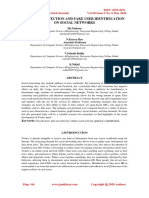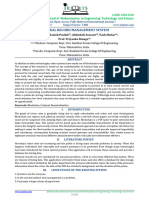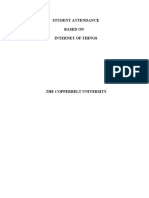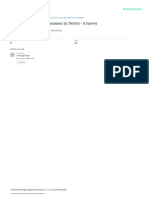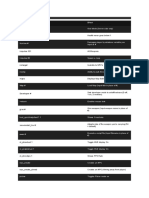Fake Account Detection Using Machine Learning Techniques
Uploaded by
mominaayman03074Fake Account Detection Using Machine Learning Techniques
Uploaded by
mominaayman03074Volume 12, Issue 4, April 2023
Impact Factor: 8.423
International Journal of Innovative Research in Science, Engineering and Technology (IJIRSET)
|e-ISSN: 2319-8753, p-ISSN: 2347-6710| www.ijirset.com | Impact Factor: 8.423| A Monthly Peer Reviewed & Referred Journal |
|| Volume 12, Issue 4, April 2023 ||
| DOI:10.15680/IJIRSET.2023.1204136 |
Fake Account Detection using Machine
Learning Techniques
Prof.V.G.Bharane, Momin Aayman Rafik, Pathan Nafisa Sharif, Suryavanshi Priyanka Dattatray
Department of Computer Engineering, S.B.Patil College of Engineering, Indapur, India
ABSTRACT—The online social networks are a very large growth in the world today, but the attacks are more
common, including one of the attacks is the attack of Twitter in this spammer spreading several malicious tweets that
can take the form of links or hash tags in the website and online services, which are too harmful for real users. To
prevent these attacks, training tweets are added and, moreover, these problems are solved by extracting 12 lightweight
functions, like the age of the account, no. of followers, no. to follow, no. of tweets, no. of re-tweets, etc. For the
transmission of spam detection from tweets, the discretization of a function is important for the performance of spam
detection. There is a great truth in the system that includes a total of 600 public tweets based on the URL-based security
tool. Spam detection primarily creates the classification model that includes binary classification and can also be solved
using the automatic learning algorithm. Machine learning algorithms such as the Naïve Bayesian classifier or the vector
support machine classifier have informed the behavior of the models. The system reported the impact of data-related
factors, such as the relationship between spam and non-spam, the size of training data and data sampling, and detection
performance. The implemented system function is the detection of simple and variable tweets of spam over time. The
system shows how spam detection is a major challenge and bridges the gap between performance appraisals and
focuses primarily on data, features and patterns to identify the real user and inform the user of spam when providing the
valuable response binary. The contribution work is to detect the tweets of spam in real time, because the new tweets
come in the form of sequences and use the updated training data set.
KEYWORDS-Machine Learning, Parallel Computing, Spam Detection, Scalability, Twitter
I. INTRODUCTION
Online social networking sites like Twitter, Facebook, Instagram and some online social networking companies have
become extremely popular in recent years. People spend a lot of time in OSN making friends with people they are
familiar with or interested in. Twitter, founded in 2006, has become one of the most popular microblogging service
sites. Around 200 million users create around 400 million new tweets a day for spam growth. Twitter spam, known as
unsolicited tweets containing malicious links that the non-stop victims to external sites containing the spread of
malware, spreading malicious links, etc., hit not only more legitimate users, but also the whole platform Consider the
example because during the election of the Australian Prime Minister in 2013, a notice confirming that his Twitter
account had been hacked. Many of his followers have received direct spam messages containing malicious links. The
ability to order useful information is essential for the academic and industrial world to discover hidden ideas and
predict trends on Twitter. However, spam generates a lot of noise on Twitter. To detect spam automatically, researchers
applied machine learning algorithms to make spam detection a classification problem. Ordering a tweet broadcast
instead of a Twitter user as spam or non-spam is more realistic in the real world.
II. PROPOSED SYSTEM
The collection of tweets with respect to trending topics on Twitter. After storing the tweets in a particular file
format, the tweets are subsequently analyzed.
Labelling of spam is performed to check through all datasets that are available to detect the malignant URL.
Feature extraction separates the characteristics construct based on the language model that uses language as a tool
and helps in determining whether the tweets are fake or not.
IJIRSET©2023 | An ISO 9001:2008 Certified Journal | 3370
International Journal of Innovative Research in Science, Engineering and Technology (IJIRSET)
|e-ISSN: 2319-8753, p-ISSN: 2347-6710| www.ijirset.com | Impact Factor: 8.423| A Monthly Peer Reviewed & Referred Journal |
|| Volume 12, Issue 4, April 2023 ||
| DOI:10.15680/IJIRSET.2023.1204136 |
The classification of data set is performed by shortlisting the set of tweets that is described by the set of features
provided to the classifier to instruct the model and to acquire the knowledge for spam detection.
The spam detection uses the classification technique to accept tweets as the input and classify the spam and non-
spammer.
Architecture
Algorithm flowchart
IJIRSET©2023 | An ISO 9001:2008 Certified Journal | 3371
International Journal of Innovative Research in Science, Engineering and Technology (IJIRSET)
|e-ISSN: 2319-8753, p-ISSN: 2347-6710| www.ijirset.com | Impact Factor: 8.423| A Monthly Peer Reviewed & Referred Journal |
|| Volume 12, Issue 4, April 2023 ||
| DOI:10.15680/IJIRSET.2023.1204136 |
DFD Diagram
Level 0
IJIRSET©2023 | An ISO 9001:2008 Certified Journal | 3372
International Journal of Innovative Research in Science, Engineering and Technology (IJIRSET)
|e-ISSN: 2319-8753, p-ISSN: 2347-6710| www.ijirset.com | Impact Factor: 8.423| A Monthly Peer Reviewed & Referred Journal |
|| Volume 12, Issue 4, April 2023 ||
| DOI:10.15680/IJIRSET.2023.1204136 |
Level 1
III. ADVANTAGES
To categories the Spammers and Non-spammers.
To work on a performance evaluation such as Precision, Recall, F-measure.
To categorize the tag based tweets and link based tweets.
To try to improve detection accuracy using deep learning algorithms.
IV. APPLICATION
Social Media Application
Spam Detection Applications
V. CONCLUSION
In this Project, System found that classifiers ability to detect Twitter spam reduced when in a near real-world scenario
since the imbalanced data brings bias. System also identified that Feature discretization was an important preprocess to
ML-based spam detection. Second, increasing training data only cannot bring more benefits to detect Twitter spam
after a certain number of training samples. System should try to bring more discriminative features or better model to
further improve spam detection rate.
REFERENCES
[1] Q. Cao, M. Sirivianos, X. Yang, and T. Pregueiro, “Aiding the detection of fake accounts in large scale social
online services,” in Proc. Symp. Netw. Syst. Des. Implement. (NSDI), 2012, pp. 197–210.
[2] G. Stringhini, C. Kruegel, and G. Vigna, “Detecting spammers on social networks,” in Proc. 26th Annu. Comput.
Sec. Appl. Conf., 2010, pp. 1–9.
IJIRSET©2023 | An ISO 9001:2008 Certified Journal | 3373
International Journal of Innovative Research in Science, Engineering and Technology (IJIRSET)
|e-ISSN: 2319-8753, p-ISSN: 2347-6710| www.ijirset.com | Impact Factor: 8.423| A Monthly Peer Reviewed & Referred Journal |
|| Volume 12, Issue 4, April 2023 ||
| DOI:10.15680/IJIRSET.2023.1204136 |
[3] J. Song, S. Lee, and J. Kim, “Spam filtering in Twitter using sender receiver relationship,” in Proc. 14th Int. Conf.
Recent Adv. Intrusion Detection, 2011, pp. 301–317.
[4] K. Lee, J. Caverlee, and S. Webb, “Uncovering social spammers: social honeypots + machine learning,” in Proc.
33rd Int. ACM SIGIR Conf. Res.Develop. Inf. Retrieval, 2010, pp. 435–442.
[5] Nathan Aston, Jacob Liddle and Wei Hu*, “Twitter Sentiment in Data Streams with Perceptron,” in Journal of
Computer and Communications, 2014, Vol-2 No-11.
[6] K. Thomas, C. Grier, D. Song, and V. Paxson, “Suspended accounts in retrospect: An analysis of Twitter spam,” in
Proc. ACM SIGCOMM Conf. Internet Meas., 2011, pp. 243–258.
[7] K. Thomas, C. Grier, J. Ma, V. Paxson, and D. Song, “Design and evaluation of a real-time URL spam filtering
service,” in Proc. IEEE Symp. Sec. Privacy, 2011, pp. 447–462.
[8] X. Jin, C. X. Lin, J. Luo, and J. Han, “Socialspamguard: A data mining based spam detection system for social
media networks,” PVLDB, vol. 4, no. 12, pp. 1458–1461, 2011.
[9] S. Ghosh et al., “Understanding and combating link farming in the Twitter social network,” in Proc. 21st Int. Conf.
World Wide Web, 2012, pp. 61–70.
[10] H. Costa, F. Benevenuto, and L. H. C. Merschmann, “Detecting tip spam in location-based social networks,” in
Proc. 28th Annu. ACM Symp. Appl. Comput., 2013, pp. 724–729.
IJIRSET©2023 | An ISO 9001:2008 Certified Journal | 3374
8.423
You might also like
- Cyberbullying Detection in Social Media Using Supervised ML & NLP TechniquesNo ratings yetCyberbullying Detection in Social Media Using Supervised ML & NLP Techniques5 pages
- The Spammer Detection and Fake User Identification On Social NetworksNo ratings yetThe Spammer Detection and Fake User Identification On Social Networks8 pages
- Fake Social Media Profile Detection and ReportingNo ratings yetFake Social Media Profile Detection and Reporting6 pages
- Spammer Detection and Fake User Identification On Social NetworksNo ratings yetSpammer Detection and Fake User Identification On Social Networks9 pages
- A Framework To Predict Social Crimes Using Twitter TweetsNo ratings yetA Framework To Predict Social Crimes Using Twitter Tweets5 pages
- Statistical Twitter Spam Detection Demystified: Performance, Stability and ScalabilityNo ratings yetStatistical Twitter Spam Detection Demystified: Performance, Stability and Scalability13 pages
- A Batch Based Approach For Tweeting Geotags of Social Media AttributesNo ratings yetA Batch Based Approach For Tweeting Geotags of Social Media Attributes13 pages
- Fake News Detection Using Machine LearningNo ratings yetFake News Detection Using Machine Learning8 pages
- Fake Account Detect From Machine LearningNo ratings yetFake Account Detect From Machine Learning4 pages
- Hate Speech Detection Using Machine LearningNo ratings yetHate Speech Detection Using Machine Learning5 pages
- Cyber Bullying Detection On Social Media NetworkNo ratings yetCyber Bullying Detection On Social Media Network9 pages
- Analysis and Optimization of Data Classification Using K-Means Clustering and Affinity Propagation TechniqueNo ratings yetAnalysis and Optimization of Data Classification Using K-Means Clustering and Affinity Propagation Technique9 pages
- Identification of Suicidal Intent Using Machine Learning Techniques Over Twitter DataNo ratings yetIdentification of Suicidal Intent Using Machine Learning Techniques Over Twitter Data14 pages
- Social Media Spam Comments Detection Analysis Using Machine LearningNo ratings yetSocial Media Spam Comments Detection Analysis Using Machine Learning6 pages
- Fraud App Detection: Jyoti Singh, Lakshita Suthar, Diksha Khabya, Simmi Pachori, Nikita Somani, Dr. Mayank PatelNo ratings yetFraud App Detection: Jyoti Singh, Lakshita Suthar, Diksha Khabya, Simmi Pachori, Nikita Somani, Dr. Mayank Patel6 pages
- 0 Comparative Analysis On Social Trust Computation in Trust Based Personalised Recommender SystemsNo ratings yet0 Comparative Analysis On Social Trust Computation in Trust Based Personalised Recommender Systems7 pages
- Web Based Machine Learning Automated Pipeline100% (1)Web Based Machine Learning Automated Pipeline6 pages
- Review Paper On Detection of Malicious URLs Using Machine Learning TechniquesNo ratings yetReview Paper On Detection of Malicious URLs Using Machine Learning Techniques4 pages
- Improving Accuracy of Twitter Fake Profile Detection Using Deep LearningNo ratings yetImproving Accuracy of Twitter Fake Profile Detection Using Deep Learning5 pages
- Social Media Analytics of The Internet of ThingsNo ratings yetSocial Media Analytics of The Internet of Things15 pages
- Cyber Security For Social Networking Sites: Issues, Challenges and SolutionsNo ratings yetCyber Security For Social Networking Sites: Issues, Challenges and Solutions7 pages
- AI Based Content Controlling System Using Age Prediction Algorithm and Selenium ToolNo ratings yetAI Based Content Controlling System Using Age Prediction Algorithm and Selenium Tool8 pages
- Personalized Mobile App Recommendation by Learning User's Interest From Social MediaNo ratings yetPersonalized Mobile App Recommendation by Learning User's Interest From Social Media5 pages
- Timeline Analysis of Twitter User Timeline Analysis of Twitter UserNo ratings yetTimeline Analysis of Twitter User Timeline Analysis of Twitter User10 pages
- Twitter Spam Detection Based On Deep Learning: Tingmin Wu, Shigang Liu, Jun Zhang and Yang XiangNo ratings yetTwitter Spam Detection Based On Deep Learning: Tingmin Wu, Shigang Liu, Jun Zhang and Yang Xiang8 pages
- Big Data Stream Mining Using Integrated Framework With Classification and Clustering MethodsNo ratings yetBig Data Stream Mining Using Integrated Framework With Classification and Clustering Methods9 pages
- Android Application of Municipality OnlineNo ratings yetAndroid Application of Municipality Online5 pages
- Analysis of Rumour Detection Using Deep Learning Methods On Social MediaNo ratings yetAnalysis of Rumour Detection Using Deep Learning Methods On Social Media10 pages
- Smart Wi-Fi Dustbin System-IJAERDV04I0479866No ratings yetSmart Wi-Fi Dustbin System-IJAERDV04I04798664 pages
- Cyber Bullying Text Detection Using Machine LearningNo ratings yetCyber Bullying Text Detection Using Machine Learning7 pages
- Twitter Data Preprocessing For Spam Detection: Myungsook KlassenNo ratings yetTwitter Data Preprocessing For Spam Detection: Myungsook Klassen6 pages
- A Review On Fake Account Detection in Social MediaNo ratings yetA Review On Fake Account Detection in Social Media7 pages
- An INTRANET-Based Web Application For College Management System Using PythonNo ratings yetAn INTRANET-Based Web Application For College Management System Using Python10 pages
- Detection of Cyber Bullying On Social Media Using Machine LearningNo ratings yetDetection of Cyber Bullying On Social Media Using Machine Learning8 pages
- Techniques To Detect Spammers in Twitter-A Survey: International Journal of Computer Applications December 2013No ratings yetTechniques To Detect Spammers in Twitter-A Survey: International Journal of Computer Applications December 20137 pages
- Sentiment Analysis Tool Using Machine Learning AlgorithmsNo ratings yetSentiment Analysis Tool Using Machine Learning Algorithms5 pages
- Karthik.S-Spammer Detection and Fake User Identification On Social NetworksNo ratings yetKarthik.S-Spammer Detection and Fake User Identification On Social Networks5 pages
- Leveled Problem Solving Least Common Multiple: LessonNo ratings yetLeveled Problem Solving Least Common Multiple: Lesson1 page
- Analysis of Three Phase Full Controlled Converter Using MATLAB/Simulink100% (1)Analysis of Three Phase Full Controlled Converter Using MATLAB/Simulink5 pages
- 1.2 Linear Equations and Rational Equations: SectionNo ratings yet1.2 Linear Equations and Rational Equations: Section15 pages
- Products Affected / Serial Numbers Affected:: TP17 212.pdf 08-11-17No ratings yetProducts Affected / Serial Numbers Affected:: TP17 212.pdf 08-11-174 pages
- Hacking With Kali Linux - A Comprehensive Beginner's Guide to Learn Ethical Hacking. Practical Examples to Learn the Basics of Cybersecurity. Includes Penetration Testing With Kali Linux by ITC ACADEMY100% (1)Hacking With Kali Linux - A Comprehensive Beginner's Guide to Learn Ethical Hacking. Practical Examples to Learn the Basics of Cybersecurity. Includes Penetration Testing With Kali Linux by ITC ACADEMY91 pages
- 7 Ways To Boot in Safe Mode in Windows 10No ratings yet7 Ways To Boot in Safe Mode in Windows 1019 pages
- White Paper Interconnect Solutions Debugging Issues Advanced ARM CoreLinkNo ratings yetWhite Paper Interconnect Solutions Debugging Issues Advanced ARM CoreLink8 pages
- Raw Waveform Processing - BayesMap Solutions, LLCNo ratings yetRaw Waveform Processing - BayesMap Solutions, LLC3 pages
- Cyberbullying Detection in Social Media Using Supervised ML & NLP TechniquesCyberbullying Detection in Social Media Using Supervised ML & NLP Techniques
- The Spammer Detection and Fake User Identification On Social NetworksThe Spammer Detection and Fake User Identification On Social Networks
- Spammer Detection and Fake User Identification On Social NetworksSpammer Detection and Fake User Identification On Social Networks
- A Framework To Predict Social Crimes Using Twitter TweetsA Framework To Predict Social Crimes Using Twitter Tweets
- Statistical Twitter Spam Detection Demystified: Performance, Stability and ScalabilityStatistical Twitter Spam Detection Demystified: Performance, Stability and Scalability
- A Batch Based Approach For Tweeting Geotags of Social Media AttributesA Batch Based Approach For Tweeting Geotags of Social Media Attributes
- Analysis and Optimization of Data Classification Using K-Means Clustering and Affinity Propagation TechniqueAnalysis and Optimization of Data Classification Using K-Means Clustering and Affinity Propagation Technique
- Identification of Suicidal Intent Using Machine Learning Techniques Over Twitter DataIdentification of Suicidal Intent Using Machine Learning Techniques Over Twitter Data
- Social Media Spam Comments Detection Analysis Using Machine LearningSocial Media Spam Comments Detection Analysis Using Machine Learning
- Fraud App Detection: Jyoti Singh, Lakshita Suthar, Diksha Khabya, Simmi Pachori, Nikita Somani, Dr. Mayank PatelFraud App Detection: Jyoti Singh, Lakshita Suthar, Diksha Khabya, Simmi Pachori, Nikita Somani, Dr. Mayank Patel
- 0 Comparative Analysis On Social Trust Computation in Trust Based Personalised Recommender Systems0 Comparative Analysis On Social Trust Computation in Trust Based Personalised Recommender Systems
- Review Paper On Detection of Malicious URLs Using Machine Learning TechniquesReview Paper On Detection of Malicious URLs Using Machine Learning Techniques
- Improving Accuracy of Twitter Fake Profile Detection Using Deep LearningImproving Accuracy of Twitter Fake Profile Detection Using Deep Learning
- Cyber Security For Social Networking Sites: Issues, Challenges and SolutionsCyber Security For Social Networking Sites: Issues, Challenges and Solutions
- AI Based Content Controlling System Using Age Prediction Algorithm and Selenium ToolAI Based Content Controlling System Using Age Prediction Algorithm and Selenium Tool
- Personalized Mobile App Recommendation by Learning User's Interest From Social MediaPersonalized Mobile App Recommendation by Learning User's Interest From Social Media
- Timeline Analysis of Twitter User Timeline Analysis of Twitter UserTimeline Analysis of Twitter User Timeline Analysis of Twitter User
- Twitter Spam Detection Based On Deep Learning: Tingmin Wu, Shigang Liu, Jun Zhang and Yang XiangTwitter Spam Detection Based On Deep Learning: Tingmin Wu, Shigang Liu, Jun Zhang and Yang Xiang
- Big Data Stream Mining Using Integrated Framework With Classification and Clustering MethodsBig Data Stream Mining Using Integrated Framework With Classification and Clustering Methods
- Analysis of Rumour Detection Using Deep Learning Methods On Social MediaAnalysis of Rumour Detection Using Deep Learning Methods On Social Media
- Cyber Bullying Text Detection Using Machine LearningCyber Bullying Text Detection Using Machine Learning
- Twitter Data Preprocessing For Spam Detection: Myungsook KlassenTwitter Data Preprocessing For Spam Detection: Myungsook Klassen
- A Review On Fake Account Detection in Social MediaA Review On Fake Account Detection in Social Media
- An INTRANET-Based Web Application For College Management System Using PythonAn INTRANET-Based Web Application For College Management System Using Python
- Detection of Cyber Bullying On Social Media Using Machine LearningDetection of Cyber Bullying On Social Media Using Machine Learning
- Techniques To Detect Spammers in Twitter-A Survey: International Journal of Computer Applications December 2013Techniques To Detect Spammers in Twitter-A Survey: International Journal of Computer Applications December 2013
- Sentiment Analysis Tool Using Machine Learning AlgorithmsSentiment Analysis Tool Using Machine Learning Algorithms
- Karthik.S-Spammer Detection and Fake User Identification On Social NetworksKarthik.S-Spammer Detection and Fake User Identification On Social Networks
- "Big Data Science" Basic Concepts and ApplicationsFrom Everand"Big Data Science" Basic Concepts and Applications
- Leveled Problem Solving Least Common Multiple: LessonLeveled Problem Solving Least Common Multiple: Lesson
- Analysis of Three Phase Full Controlled Converter Using MATLAB/SimulinkAnalysis of Three Phase Full Controlled Converter Using MATLAB/Simulink
- 1.2 Linear Equations and Rational Equations: Section1.2 Linear Equations and Rational Equations: Section
- Products Affected / Serial Numbers Affected:: TP17 212.pdf 08-11-17Products Affected / Serial Numbers Affected:: TP17 212.pdf 08-11-17
- Hacking With Kali Linux - A Comprehensive Beginner's Guide to Learn Ethical Hacking. Practical Examples to Learn the Basics of Cybersecurity. Includes Penetration Testing With Kali Linux by ITC ACADEMYHacking With Kali Linux - A Comprehensive Beginner's Guide to Learn Ethical Hacking. Practical Examples to Learn the Basics of Cybersecurity. Includes Penetration Testing With Kali Linux by ITC ACADEMY
- White Paper Interconnect Solutions Debugging Issues Advanced ARM CoreLinkWhite Paper Interconnect Solutions Debugging Issues Advanced ARM CoreLink






